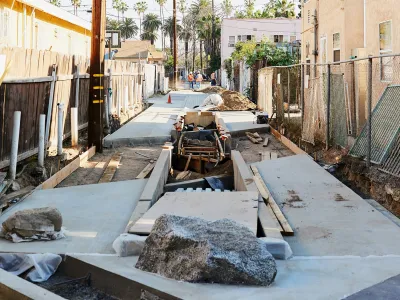Rather than shuttling stormwater away from the city and into the ocean as quickly as possible, Los Angeles is now—slowly—moving toward a ‘city-as-sponge’ approach that would capture and reclaim more water to recharge crucial reservoirs.

A program that installed green infrastructure in Los Angeles alleyways got its first real test last month as massive storms pummeled the region, bringing rain that overwhelmed much of Southern California’s stormwater infrastructure. As Alissa Walker writes in Curbed, thanks to the “green alleys” installed as part of a 2015 project in South Los Angeles, “the resulting stormwater had more opportunities to sink back into the earth: filtering through a row of permeable pavers, directing to pocket planters where creeping fig vines twirl up garage walls, or vanishing into grates labeled ‘drains to groundwater.’”
Walker explains that “a single green alley is able to capture enough stormwater per year to store it in dry wells below the pavers where it can slowly percolate into the groundwater, says Allen Compton, founder of the landscape architecture firm SALT, which designed these alleys.” The alleys connect to the South L.A. Wetlands Park, another key piece of green infrastructure that collects stormwater and provides habitat for local wildlife.
As storms become more intense and unpredictable, paved-over cities like Los Angeles can use permeable materials and sustainable design elements to capture and reclaim stormwater more effectively, recharge groundwater reserves, and prevent damaging floods. But “Because stormwater is still erroneously classified as a waste product, its management is handled by the same department that picks up the trash,” while other efforts are scattered across city and county agencies. According to Walker, Los Angeles is developing an interagency stormwater plan that would streamline and coordinate stormwater management efforts.
FULL STORY: L.A.’s ‘Green Alley’ Experiments Are Working”

National Parks Layoffs Will Cause Communities to Lose Billions
Thousands of essential park workers were laid off this week, just before the busy spring break season.

Retro-silient?: America’s First “Eco-burb,” The Woodlands Turns 50
A master-planned community north of Houston offers lessons on green infrastructure and resilient design, but falls short of its founder’s lofty affordability and walkability goals.

Delivering for America Plan Will Downgrade Mail Service in at Least 49.5 Percent of Zip Codes
Republican and Democrat lawmakers criticize the plan for its disproportionate negative impact on rural communities.

Test News Post 1
This is a summary

Test News Headline 46
Test for the image on the front page.

Balancing Bombs and Butterflies: How the National Guard Protects a Rare Species
The National Guard at Fort Indiantown Gap uses GIS technology and land management strategies to balance military training with conservation efforts, ensuring the survival of the rare eastern regal fritillary butterfly.
Urban Design for Planners 1: Software Tools
This six-course series explores essential urban design concepts using open source software and equips planners with the tools they need to participate fully in the urban design process.
Planning for Universal Design
Learn the tools for implementing Universal Design in planning regulations.
EMC Planning Group, Inc.
Planetizen
Planetizen
Mpact (formerly Rail~Volution)
Great Falls Development Authority, Inc.
HUDs Office of Policy Development and Research
NYU Wagner Graduate School of Public Service



























